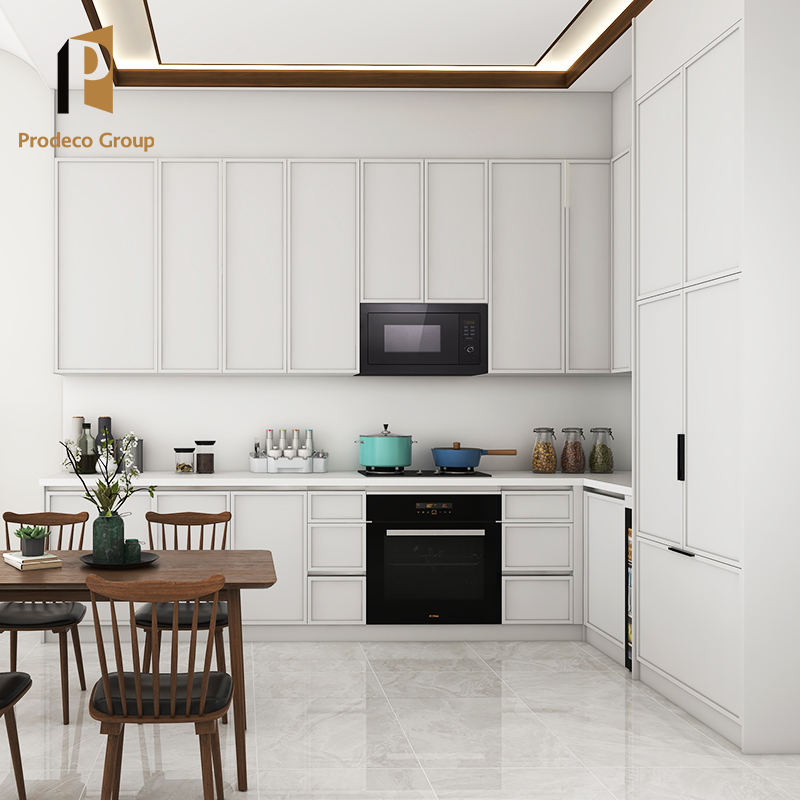Cabinets are the soul of a kitchen, which directly determines whether the kitchen is useful or not. For those who love to cook, if the kitchen cabinet design is unreasonable, the cooking is not smooth, and the mood to play new dishes is gone.
Smooth movement
There are four types of moving lines in the cabinet: one-shaped, two-line, L-shaped and U-shaped, but no matter which one is, the order of cooking must be considered-take the ingredients from the refrigerator, wash the vegetables in the sink, cut the vegetables and prepare them, Stir-fry, assemble the pan, the smoother the movement, the better, and reduce unnecessary movement.
In-line type: suitable for narrow kitchens, but this layout is not easy to use, because cooking is not a one-line operation, interspersed with water, picking vegetables, washing knives and spoons, etc., you need to walk back and forth.
Two-line type: Suitable for kitchens with a kitchen door on one side and a balcony door on the other. There is a passage in the middle. This requires the width of the kitchen. The enclosed layout can shorten the distance of walking back and forth, and you can wash and cut vegetables when you turn around.
L-shaped: This is the most common layout for small and medium-sized kitchens. Compared with the double-line type, the corner space is also used. The refrigerator is recommended to be placed next to the sink, and the ingredients can be washed directly after taking them out, so that the flow is smoother.
U-shape: This layout is recommended for large kitchens, with plenty of storage space, wide operating table feet, and enough space for bending and turning to accommodate multiple operations. But compared with the L-shape, it has an extra corner, which is easy to form a chicken rib space, so it should be designed reasonably.

Suitable height
Regardless of whether it is a base cabinet or a wall cabinet, the height of the cabinet must be considered the height of the cook. If the wall cabinet is too low, tall people will easily hit the cabinet, and if the wall cabinet is too high, short people will not be able to reach it.
You can refer to these dimensions when designing kitchen cabinets:
Below 165 in height, the height of the cabinet is 80cm;
The height is above 165, the height of the cabinet is 85cm;
The stove itself has a little height, so you should hold your arms while cooking. It is best to lower the height of the stove top appropriately, and it is better to be 7-10cm lower than the operating countertop next to it;
The height of the wall cabinet is 50-60cm, and the distance from the ground is 145-150cm. The bottom of the wall cabinet is about 50-60cm away from the operating table. This size is suitable for the height of most cooks. You can open the cabinet to take things without stepping;
There is a gap between the depth of the floor cabinet and the wall cabinet. The depth of the cabinet floor cabinet (including the countertop) is generally about 60cm, the depth of the floor cabinet is 56cm, and the depth of the wall cabinet is 32cm.

Reasonable internal layout
Cabinets
The floor cabinets should be designed with large and thin combined drawers as much as possible. The first layer is designed with thin drawers and small pieces of tableware are placed.
Tableware and other tableware are sorted and stored in a flat style, so things are clear at a glance, and it is more convenient to lean over to get them, so you don’t need to squat down and search.
A flip drawer can be made near the operating table to store cleaning items.
Do not use drawers in the sink area. Reserve sockets for water purification equipment, small kitchen treasures, and garbage disposers. Then use auxiliary tools, such as telescopic shelves, to make use of irregular corner spaces.
The corners of the L-shaped and U-shaped cabinets are easy to waste, which can be solved perfectly by installing a rotating pull basket or a corner drawer.
Wall cabinet
The inconvenience of the wall cabinet is that it is too high and inconvenient to take. It can be designed in layers with two upper and lower doors, or an open partition + wall cabinet combination.
The lifting basket is installed in the wall cabinet, which is specially designed for kitchen cabinets that are too deep and too high.
Wall
The wall space between the wall cabinet and the floor cabinet should also be used. Small cabinet doors are installed at the L-shaped corners to hide all the small appliances.
Hanging rods or partitions are installed above the sink or vegetable preparation area, and hooks are used to store various rags, hand towels, props, and spatulas.
Wardrobe
If there is space, you can directly make a cabinet, which perfectly solves all kinds of storage in the kitchen and liberates the work surface.










